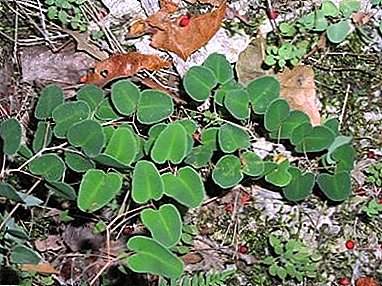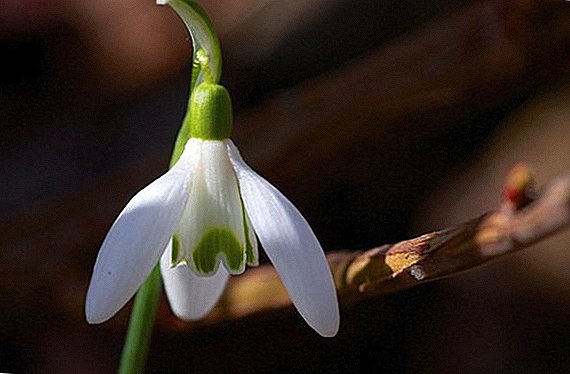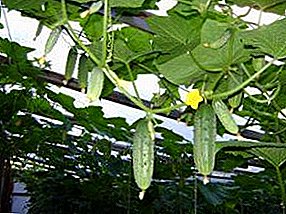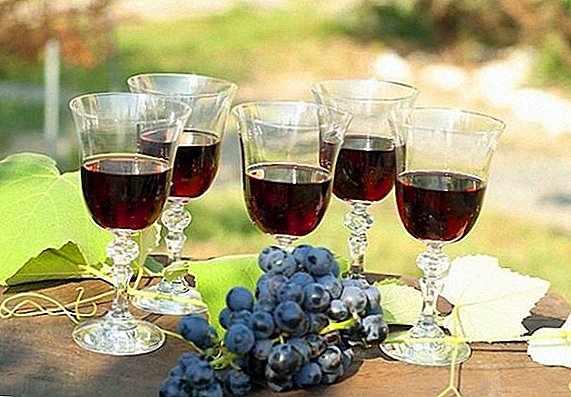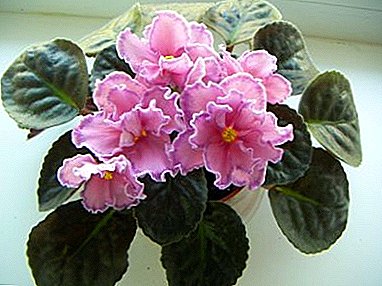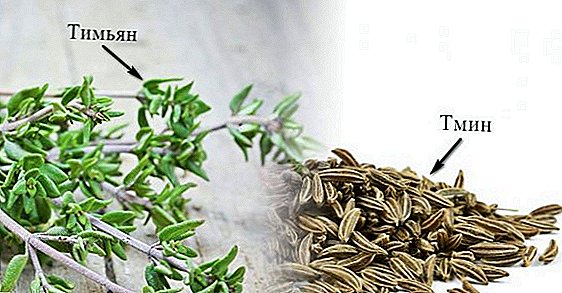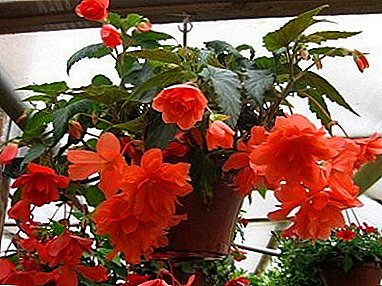
Dream to plant a seed in the ground and grow luxury flower? If this is the seed begonia of ampelous, then your dream is not transcendental. Even a beginner amateur gardener will be able to cope with this task, and our article will be a good help.
Botanical description
Tuberous perennial with bulk stems and asymmetrical leaves. The height of the stem is 20–60 cm, and the length of the leaves is 10–20 cm. The Begonia Pendula is notable for its long (30–40 cm, and in some varieties up to 1 m) drooping shoots. For this it is also called hung begonia. She has single-sex, monoecious flowers of bright tones with a diameter of about 5 cm. In some varieties, the flowers are larger.

If this happened to you - do not worry! These flowers are female. Take care of your plant, watch the watering, and soon the wonderful male flowers will bloom on your begonias.
We grow at home
In this section, we will talk about how to grow a hung begonia on our own.
Select the conditions for landing
The correct landing time is February or March. Such terms are related to the fact that she has a long growing season. If you are late in planting and leaving, then it can bloom only by the end of summer.
Tubers that you buy for planting must be healthy: medium size, dense, round. Try to feel them before you buy, because the appearance of the future plant depends on them.
Prepare the pots in advance! Capacities for landing should be small, but wide. The presence of drainage holes required! At the bottom of the pot should lie broken shards and drainage. The soil needs porous, breathable, nourishing.
Plant begonia
Before planting, keep the tubers in a moist, light heat. That is, “plant” the lower part of the tuber on a moist warm cloth or other material and leave it in the light. As soon as small white roots appeared from the bottom - the tubers are ready for planting.
Potted soil pre-moisten (but do not fill, spraying a spray bottle is good enough). Plant tubers on it with the part where the roots appeared. The space around the tubers close ground, but not to the top. The top of the tubers should remain open until sprouts appear.
Water the planted begonias need to be careful. Water must not be allowed to enter the tuber itself.
Transfer
The flower is planted on a permanent place of growth in May. Given that the surface layer of the soil always dries quickly, the tubers need to be slightly “drown” in the ground. Literally 1-2 cm. The land itself must be fertile.

If you plant one tuber per pot, its diameter should not exceed 13-15 cm. Also, do not choose too deep pots, because Begonias have a more superficial root system.
The deeper the capacity, the faster the lower layers of the soil will be acidified, and begonia does not like it. But very low pots do not fit.
Do not forget that at the bottom of the tank should be a place for drainage to remove excess water. Pot material does not matter, but it’s important so that there are drainage holes on its bottom (5-6 pieces).
Caring for begonia
The plant does not tolerate waterlogging. For it, lower watering is recommended: directly into the pan or along the edge of the tank, avoiding contact with the tubers. Summer, in the period of constant flowering, watering should be plentiful, but remembering that everything is good in moderation. In winter, refusing watering is not necessarybut do it carefully and little by little.
An ideal place to grow - diffused sun or light penumbra. The flower does not like direct sunlight because of the risk of burns on succulent green leaves. And the lack of light threatens to stretch the shoots and the lack of flowering.
This specimen likes to grow. at a temperature of 19ºС, but it will withstand with ease and 25 and 12ºС. At home, begonia should be protected from elevated temperatures in the winter. Provide it with fresh air and airing - it strengthens it.
To support the begonia during the long flowering period, it needs to be fed once every few weeks. Fertilizer should be liquid, complex and well, if it is intended specifically for begonias. Be careful with nitrogenous fertilizers - they provoke the growth of leaves, there will be no forces left to bloom.
Bloom

For a long period of flowering, this plant is called ever-flowering. From May to November the begonia is covered with ampelous flowers. Male flowers are larger, more elegant, terry, female simple, Consisting of only 2-5 petals. One flower lasts about ten days, and new ones immediately appear to replace it.
Rest period lasts about 3.5 months - from November to early March. At this time, it does not need to bother (but remember about the very unhurried, careful watering).
Breeding
Breeding begonia ampelous seeds, cuttings, tubers.
The most labor-intensive method of reproduction is growing ampelous begonia from seeds. They are really tiny: 50,000 pieces per 1 gram of raw seed. They are sown on loose earth, not sprinkled on top of a layer of soil. From above cover with a film to keep humidity and heat inside. All this time it takes constant watering so that the seedlings do not dry out. After 3 months, the plant spikes into the pot.
Cuttings - the most affordable way to grow begonia. Put 10 centimeter cuttings of the overwintered begonia into the water and wait until the sprouts go. Then plant the cuttings in pots of 5 cuttings per pot.
At tuberous reproduction, cut off parts with 2-3 buds are sprinkled with charcoal powder. Another option is colloidal sulfur. So they are dried, and then planted in the usual way.
How to save ampelous begonia in winter?
With the onset of autumn watering plants need to be reduced. By the end of November, watering stops completely. The aboveground part of the branch will fall off (the leaves) and dry out (the stems), but it is not necessary to cut it. Tubers remain in the pot for the whole winter and stored at 10-15ºС.
One plant will delight its flowering 4-5 years.
Pests and diseases
Ampelous begonia is not a painful plant, but it also has trouble. It's a gray rot - rot on the leaves and shoots of the flower; powdery mildew - white bloom on the leaves; Bacterial blotch - disease backside of the leaves of begonias. From these misfortunes will help spraying special solutions.
Of insects, the pseudoprotector is soft, aphid, whitefly and others. Spraying is also suitable for combating them (pick up the product based on the parasite), and in some cases it may be necessary to remove part of the plant.
Try to grow an ampelous begonia next summer, and you will admire this flower. Gentle or passionate - she will lift your spirits anyway.
A photo
Next you can see the home care photos for the ampelous begonia:






